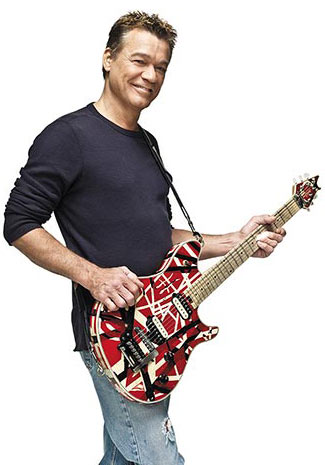
Recently, guitarist Eddie Van Halen donated his guitar, the Frank 2, to the National Museum of American History. Smithsonian corresponded with him via email about his decision to give up his cherished guitar.
“Eruption” is widely regarded as one of the greatest-if not the greatest-guitar solos ever. What’s the best guitar solo you ever heard performed by another musician?
There are so many, it’s difficult to pinpoint it down to one.
You’ve collaborated on projects with a number of musicians over the years, including Brian May, Geezer Butler, and Thomas Dolby. Do any collaborations stand out as your favorite?
Michael Jackson’s “Beat It” is a stand out for me. Quincy Jones called me up and asked me to play on it. When I got there it took me 15 minutes to rearrange the song and I played 2 solos and told them they could pick the one they liked best. Then Michael walked in and said wow! I really like that high fast stuff you do. It was a lot of fun to do. Its crazy that something could take such a short amount of time and can grow into something beyond anything you could ever imagine.
You patented a “musical instrument support.” What is that?
That patent came out of a technique I used when playing the guitar’s fingerboard: laying it flat, using both of my hands at the same time. To do this I needed the fingerboard to face upward like the keyboard of a piano. The device I patented enabled me to do that. It also comes in very handy for lap steel players.
You donated Frankenstein 2 to the Smithsonian, but tell us about the original Frankenstein.
The original Frankenstein was a result of me tinkering and experimenting with different elements of electric guitars that I liked. The thing was that some guitars had elements that I liked, but at the same time had certain elements that I didn’t care for either. If I could combine those elements into one guitar, then I could have an instrument that enabled me to create and play what I heard in my head without any restrictions.
You’ve said that you hated “store-bought, off-the-rack” guitars, because they would not do what you wanted them to do. What did you want from your guitar?
I wanted the electronics (humbucking pickups) of one manufacturers guitar, while I preferred the body, neck and tailpiece of another manufacturers guitar.
And how did you achieve that?
I combined the 4 elements into Frankenstein, which resulted in a guitar that did what I wanted it to do, more than anything I had ever played before. In addition, I created an instrument that wasn’t offered as an “off the rack” guitar by any manufacturer at the time.
What became of Frankenstein 1?
I retired it from regular use. It took so much abuse from endless touring and recording; I wanted to pay some respect to it and let it survive and not let it get destroyed completely. At the same time it became something so well known beyond my wildest dreams that it’s value made it a target for theft and I wanted to protect it. I still play it every now and then. It’s priceless to me.
What did you think of Frankenstein 2, the first time you played it?
I was blown away. We did a blindfold test and it took me a while to figure out which one was the original and which one was Frank 2. The aesthetic accuracy was astounding.
And how did the Replica Frank 2 compare to the original?
From a playability stand point Frank 2 was actually easier to play and fought me less than the original. Frank 1 was something I built around 1975, so it reflected my experience in building guitars at that time.
How could you part with it?
What better home for it than the Smithsonian Institution where it could be on display for the rest of time so others can appreciate it. It’s the highest honor I could imagine for something so dear to me.


No comments:
Post a Comment